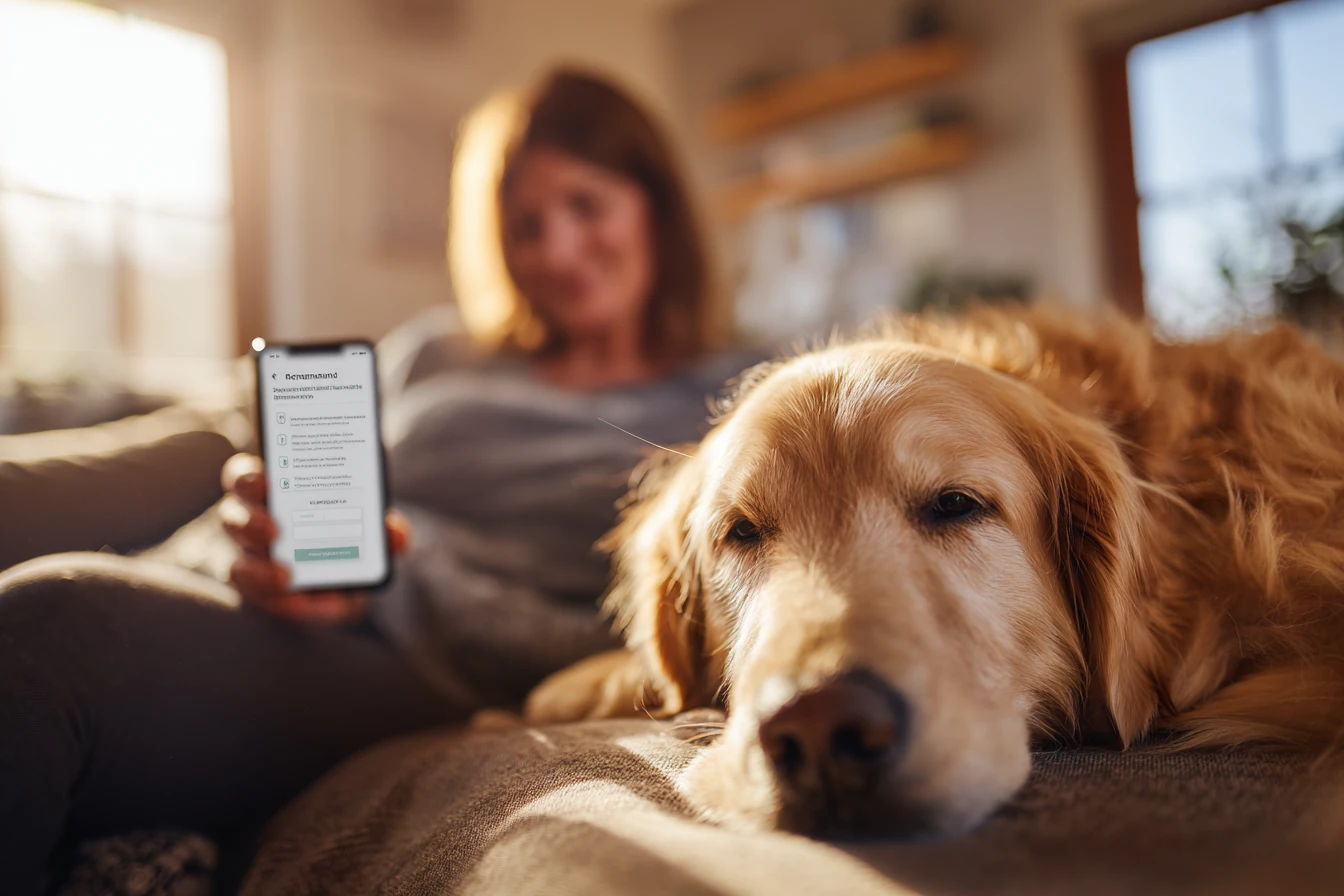Veterinary Client Communication Software: A Complete 2025 Guide for Practice Managers and Owners
Veterinary client communication software guide for 2025. Compare platforms, understand TCPA compliance, implement SMS workflows, and measure ROI.

If you manage a veterinary practice, you already know that communication drives everything. The appointment that gets confirmed shows up. The client who understands discharge instructions calls less. The pet owner who receives a gentle refill reminder keeps their animal healthier and your revenue steadier. Veterinary client communication software makes all of this happen at scale, without burning out your front desk team.
This guide walks you through what veterinary client communication software actually is, how to choose the right platform for your practice, and how to implement it in a way that produces real results within the first month. We'll cover compliance requirements you can't ignore, workflows that pay for themselves, integration considerations with your PIMS, and the metrics that matter when you present ROI to your owners.
What Veterinary Client Communication Software Actually Does
Let's start with a working definition. Veterinary client communication software is a platform that helps your clinic communicate with pet owners through multiple channels—typically SMS, email, voice, and sometimes in-app messaging or push notifications. The core job is operational communication: appointment reminders, recalls for overdue wellness visits, discharge instructions after surgery, prescription refill reminders, lab result notifications, and two-way conversations when clients have questions.
This is different from marketing automation, which focuses on newsletters, promotional campaigns, and client acquisition. While there's overlap—some platforms do both—your day-to-day operations benefit most from reliable, compliant, two-way messaging that integrates with your practice management system and keeps your team organized.
Most modern veterinary client communication software includes a shared inbox where your team can see all client conversations in one place, tag threads by priority, assign ownership, and track response times. Think of it as a command center for every text, email, and missed call that comes into your practice.
Why This Category Matters More Than Ever
Ten years ago, practices could get by with phone calls and postcards. Today, clients expect the convenience they get from their human healthcare providers, their kids' schools, and even their favorite restaurants. They want to confirm appointments with a single tap, ask a quick question about their dog's incision without sitting on hold, and receive their cat's lab results in a secure portal they can access from their phone.
Veterinary client communication software meets those expectations while reducing the operational burden on your team. When implemented correctly, it cuts no-show rates, increases chronic medication adherence, speeds up response times during business hours, and creates a better experience for everyone involved. It also generates the kind of data you need to make informed decisions: which workflows are working, which clients are slipping through the cracks, and where your team is spending too much time.
Understanding Communication Channels and When to Use Each
When vendors talk about "multi-channel communication," they're simply describing the different paths you use to reach clients. Each channel has strengths, and understanding them helps you match the right message to the right medium.
SMS and MMS are your fastest option for time-sensitive communication. Text messages get opened within minutes, which makes them ideal for appointment confirmations, quick questions, and photo exchanges. MMS allows you to send or receive images, which is invaluable for wound checks, rash updates, or showing clients where to find their pet's medication instructions. The key with texting is brevity—keep messages short, include one clear next step, and move longer instructions to email or a portal.

Email is better suited for content that requires more detail. Discharge summaries, pre-operative instructions, itemized invoices, and educational resources all work better in email format where you can use headings, bullet points, and attachments. Clients may not open email as quickly as a text, so reserve it for information that will still be relevant a few hours later.
Voice and missed-call-to-text workflows help manage phone volume during peak hours. When your front desk is swamped and someone hits voicemail, an automated text can offer an alternative path: "Sorry we missed you—reply here and we'll get back to you shortly." This keeps the conversation moving without forcing clients to wait on hold or call back repeatedly.
Push notifications work when clients are actively using your mobile app or client portal. They're effective for nudging someone to complete a half-finished form, view lab results that just arrived, or pay an outstanding balance. Since push requires app adoption, you'll want to promote your app consistently through in-clinic signage, email footers, and verbal invitations during checkout.
Web chat creates a friendly entry point on your website. The best implementations capture the initial inquiry through chat, then transition the conversation to SMS once the visitor leaves your site. This gives you continuity and gives the client a convenient place to continue the thread later.
Compliance Requirements You Cannot Skip
Let's address the regulatory side without making it intimidating. Veterinary client communication software operates in a world governed by rules designed to protect consumers from spam and unwanted calls. If you text clients without following these rules, you risk fines, deliverability problems, and damage to your practice's reputation.
TCPA stands for the Telephone Consumer Protection Act. It's the foundational law that governs business texting and calling in the United States. The core requirement is simple: you must have prior express consent before sending marketing or non-emergency texts to a client's mobile phone. In practical terms, this means adding an opt-in checkbox to your new client forms, verbally confirming consent during phone calls, and honoring opt-out requests immediately when someone texts "STOP."
A2P and 10DLC describe the technical infrastructure that makes business texting work. A2P means "Application-to-Person"—your veterinary client communication software sends texts to clients' phones, as opposed to person-to-person texting between individuals. 10DLC stands for "10-Digit Long Code," which refers to the standard phone numbers that look like regular local numbers but are registered for business use.
To send texts reliably, you need to register your business (called your "brand") and describe your use cases (called "campaigns") with the mobile carriers. This process tells carriers that you're a legitimate veterinary practice sending appointment reminders, not a spammer. Most reputable veterinary client communication software vendors will help you through this registration process, but you're ultimately responsible for providing accurate business information and following acceptable use policies.
Consent capture and storage are where many practices stumble. You need to document who consented, when they consented, how they consented (online form, verbal, paper), and which channels they approved. Store this information somewhere you can retrieve it for audits. Your veterinary client communication software should provide consent logging and export capabilities. Train your front desk to capture consent consistently, and make opt-out as easy as opt-in.
Security and privacy deserve attention even though most veterinary practices aren't subject to HIPAA, which applies only to human healthcare. Your clients still expect you to protect their contact information and their pets' medical records. When evaluating veterinary client communication software vendors, ask for documentation of their security controls.
A SOC 2 report is the industry-standard way to verify that a vendor takes security seriously. SOC 2 Type I means an auditor checked that security controls exist on a specific date; Type II means the controls worked effectively over a period of time, usually six to twelve months. You don't need to read the full report, but requesting a summary separates mature vendors from those operating without oversight.
Look for encryption in transit (data moving between your browser and the vendor's servers) and encryption at rest (data stored on their servers). Confirm that the vendor supports role-based permissions so front desk staff can send messages but can't export your entire client database. If you use Microsoft 365 or Google Workspace, ask whether the vendor supports single sign-on (SSO), which simplifies password management and makes offboarding departing employees cleaner.

Starting with Outcomes, Not Features
Before you compare vendor feature lists, decide what success looks like for your practice. The biggest mistake practices make when adopting veterinary client communication software is focusing on activity instead of outcomes. Sending 500 appointment reminders feels productive, but it doesn't matter unless your no-show rate drops.
Pick two goals for your first month—one operational goal and one client care goal. For example: reduce no-shows by two percentage points, and cut average response time in the shared inbox to under ten minutes during business hours. Write these down, share them with your team, and review progress every Friday for four weeks.
You don't need a data analyst to measure success. Pull last month's numbers from your PIMS—total appointments, total no-shows, total prescription reminders sent, total refills completed. Calculate the baseline percentages. Then track the same numbers weekly after you implement your veterinary client communication software. Keep a simple scorecard on a shared spreadsheet or even a sticky note: baseline, target, current week.
Reducing no-show rates is the most common first win. Confirm more appointments through automated reminders, and you'll fill last-minute gaps faster when clients cancel with notice. A realistic goal is a one- to two-point drop in no-show rate within 30 days. One fewer no-show per day often pays for the entire software investment.
Increasing medication and diet refill adherence improves patient outcomes and creates predictable revenue. Pick three product categories—dermatology medications, joint supplements, cardiac diets—and track refill completion rates against reminders sent. Better adherence means healthier pets and fewer emergency visits.
Speeding up first response time in your shared inbox reduces phone pressure and builds client trust. During open hours, measure the minutes between when a client sends a message and when a staff member replies. Aim for under ten minutes for most threads and under two minutes for messages tagged as urgent.
Growing review volume turns satisfied clients into public advocates. Count new Google reviews per week and track your average star rating. More recent reviews improve local search rankings and reduce your marketing spend because potential clients trust peer recommendations.
High-Value Workflows You Can Launch in Week One
Veterinary client communication software delivers value through repeatable workflows—automated sequences that trigger based on appointments, reminders, or patient status. You don't need a six-month project plan to see results. In week one, pick one workflow from each phase below, configure it in an afternoon, and review outcomes every Friday.
Pre-Visit Workflows
Pre-visit communication sets expectations before clients arrive and reduces no-shows. Build a two-step reminder sequence: 48 hours before the appointment and two hours before. Include a one-tap confirm or reschedule link, parking instructions, and a link to your online intake form.
For services with high no-show rates—new puppy exams, dental procedures, specialist referrals—consider adding a deposit requirement or card-on-file policy. A simple SMS might read: "Hi Sarah, Max is scheduled for his dental cleaning on Thursday at 9 a.m. Reply C to confirm or R to reschedule. Complete your pre-visit form here: [link]."

Track confirmation rates by channel and watch your no-show rate week over week. Most practices see confirmation rates above 80% and no-show rates drop two to four percentage points within the first month.
Day-of-Visit Workflows
Day-of-visit communication keeps your front desk moving and reduces hold times. Enable curbside or contactless check-in using a QR code at your entrance. When clients scan the code, they complete a short form—vehicle description, pet name, reason for visit—and your team knows who's waiting.
Create quick-reply templates for "we're running 15 minutes behind" and "your exam room is ready." Connect your phone system to your veterinary client communication software so that anyone who reaches voicemail receives an automatic text: "Sorry we missed you. How can we help? Reply here, or we can call you back shortly."
Add a payment link to your post-visit texts so clients can settle their balance without waiting at the front desk. Track first response time during open hours and daily voicemail counts. Most practices cut voicemail volume in half and improve response times to under eight minutes.
Post-Visit Workflows
Post-visit communication closes the loop on care instructions, reduces callbacks, and surfaces service recovery opportunities early. Create three discharge templates—surgery, dentistry, and general illness—and keep SMS concise by linking to full instructions in email or your client portal.
Schedule a next-day check-in: "Hi Sarah, how is Max doing after his dental? All good, or any concerns?" For diagnostics, send a results notification with a secure link and ask clients to reply "READ" when they've reviewed the information.

Include a micro-survey with every post-visit sequence: "Was communication clear today? Yes or No. Anything we could improve?" This two-question survey takes 15 seconds to complete and gives you actionable feedback. Track instruction read rates, results acknowledgment within 48 hours, and survey response rates. Aim for 90% positive responses.
Ongoing Care Workflows
Ongoing care communication protects patient health between visits and reactivates clients who drift away. Build recall sequences for wellness visits, vaccines, and annual exams: 30 days before due, on the due date, and 14 days overdue. Then hand off to email or phone outreach.
For prescription refills, send a reminder when the medication is due with a one-tap request link, then a gentle nudge at day seven if the client hasn't responded. For reactivation campaigns, run a monthly list of clients with no visit in 14 months and send a friendly note: "We miss Max! If you need us, scheduling is simple: [link]."

Track recall completion rates, refill capture rates, and reactivation bookings per 100 messages sent. Most practices see refill capture improve by 10 to 15 percentage points and reactivation booking rates of 5 to 8%.
Integrating with Your PIMS and Other Tools
Veterinary client communication software works best when it knows three things: who the client is, what the patient needs next, and what just happened during the visit. Most of that information lives in your practice management system. A strong integration means fewer manual steps, fewer data entry errors, and faster workflows.
There are three common levels of PIMS integration. Basic read-only sync imports clients, patients, appointments, and reminders on a schedule—hourly or nightly. This works for single-location practices with simple needs, but you may feel delays between when something changes in your PIMS and when your veterinary client communication software reflects that change.
Near-real-time sync moves data via API or webhooks within a few minutes. Your veterinary client communication software can update reminder statuses, log communications, and write appointment confirmations back to your PIMS. This fits most practices and provides the responsiveness you need during business hours.
Full bidirectional integration allows the platform to create or modify records—appointments, client contact information, even medical notes—and post them back to your PIMS. This is powerful but requires careful permission management so staff don't accidentally overwrite critical fields.
Before you trust an integration, validate exactly what syncs. Confirm that clients, patients, species, breed, contact information, reminders, appointments, invoices, consent flags, and opt-out preferences all flow correctly. Ask how the system matches records—by client ID from the PIMS, by phone number, by email—to prevent duplicate client profiles.

Agree on sync frequency and latency targets. During business hours, you want appointment changes and reminder updates to sync within five minutes. Ask what happens when there's a conflict—if a phone number changes in both systems simultaneously, which one wins? Establish a clear source of truth and document the conflict resolution rules.
For multi-location practices, verify that location codes and provider calendars map correctly so messages and scheduling links route to the right place. Confirm whether historical data—past reminders and appointments from the last 24 months—will be imported during setup.

Request sandbox access so you can test the integration with real scenarios before going live. Run a simple smoke test: change a phone number in your PIMS and confirm it appears in the platform within minutes. Create an appointment, check that a reminder fires, and verify that the confirmation writes back. Cancel the appointment and watch the system update.
Beyond PIMS integration, consider complementary connections that reduce manual work. Payment integrations enable quick-pay links, card-on-file functionality, and automatic ledger reconciliation. Digital form and e-signature tools allow mobile-friendly intake and consent forms that write directly into the PIMS. Telemedicine integrations handle scheduling and secure photo sharing with documentation back to the chart.
Phone system integration provides caller ID screen pops, click-to-call, and missed-call-to-text workflows. Review site integrations automate Google review invitations tied to visit types. Online pharmacy integrations let refill requests map directly to the correct medication in your PIMS.
When evaluating vendors, ask which PIMS versions they support and whether the integration is certified by the PIMS vendor. Request a written list of fields and objects that sync, typical sync times during business hours, and visibility into sync failures. Confirm that you can export all of your data—both conversations and sync logs—at any time.
Evaluating Features That Actually Matter
Vendor feature lists can feel overwhelming, so approach them like a trade show: decide what you need before you walk in, then test it live. Keep a simple scorecard—yes, no, or needs follow-up—and resist the urge to add features just because they sound interesting.
Start with must-haves. Two-way SMS with MMS support enables fast back-and-forth communication for triage, photo sharing, and quick clarifications. Send a test photo from your phone and confirm it lands in the shared inbox attached to the patient record.
Automated reminders and recalls reduce no-shows and improve series care completion. Build a 48-hour plus 2-hour reminder sequence with a confirmation link, then cancel the appointment in your PIMS and verify the automation stops.
Shared inbox triage with tags and assignment keeps your team organized. Tag a thread "urgent," assign it to a specific user, and confirm that alerts and working-hours rules function correctly.
Templates with merge fields ensure consistent tone and accurate details. Create a template that pulls {FirstName}, {PetName}, {Date}, and {Time}, then send it to a test number to verify formatting.
Segmentation and filters prevent sending the wrong message to the wrong clients. Filter by species, wellness plan status, or overdue recalls, then preview recipients before sending.
Deliverability visibility tells you whether messages are actually reaching clients. Look for per-carrier delivery status, failure reasons, and automatic retry logic.
Consent capture and opt-out handling keep you TCPA-compliant. Text "STOP" from your test number and confirm the system suppresses future messages and logs the opt-out with a timestamp.
Audit trails and permissions provide accountability. View who sent what and when, restrict exports to managers, and confirm that front-desk staff cannot change system-wide settings.
Multi-location branding and routing ensure the right phone number and sender name appear for each location. Send from two different locations and check that headers, links, and callback numbers are location-specific.
Reporting with exports gives you the data you need for weekly reviews. Export confirmation rates by provider, first response times during open hours, and refill capture rates for a specific date range.
Nice-to-have features can move the needle but aren't dealbreakers. Missed-call-to-text converts voicemails into shared inbox threads. Digital payment links speed up checkout. Deep links to online scheduling reduce abandoned bookings. AI-suggested replies draft responses that your team can edit before sending.
For each nice-to-have, ask the vendor to demonstrate it live and explain any additional fees—per message, per push notification, or per payment transaction.

AI Features That Save Staff Time
Artificial intelligence in veterinary client communication software should feel like power steering: it amplifies your team's effort without taking control. The goal is simple—reduce clicks, shorten replies, and keep conversations moving while clinicians stay in the loop.
Intent and priority tagging reads incoming messages and labels them: refill request, appointment change, post-op concern, billing question. Urgent items move to the top of the queue automatically, so your team stops triaging by hand.
Smart routing sends refills to the pharmacy workflow, billing questions to the front desk, and medical questions to a technician or veterinarian. This eliminates the step where someone has to decide who should handle each thread.
Suggested replies draft short, friendly responses that include merge fields. Your staff reviews, edits, or discards the draft. Think of it as a starting point, not the final word.

Knowledge snippets surface answers your clinic has used before—"How do I prepare for a dental?"—so staff don't hunt through old emails every time the same question comes up.
Photo and file summaries generate a short description for an incision photo or rash update and suggest a next step: call today or check again in 24 hours. Humans always confirm before sending clinical advice.
Thread summaries condense long conversations into five bullet points so the next person can jump in without rereading everything. This is especially useful during shift changes or when a manager needs to review an escalated thread.
To test AI in a demo, paste a real message with mixed topics—"Can I move Fluffy to Thursday, and we need more Apoquel"—into the vendor's inbox. Check that the system tags it correctly, routes each part appropriately, and drafts a coherent reply. Edit one sentence and send. Attach a test photo and ask for a summary. The result should be concise and should never make unsupported medical claims.
Guardrails matter. AI should draft, staff should send. For anything clinical or emotional, humans decide. Look for confidence indicators—low-confidence drafts should be clearly labeled. Audit trails should capture who accepted which draft and what changed. Per-user controls let you enable AI for the front desk first, add technicians next, and keep veterinarians in opt-in mode.
Measure AI effectiveness through first response time, average handle time, and adoption rate. Track how often staff must heavily edit or discard drafts—this should trend down over time. Include a one-question survey at checkout: "Was communication clear today?" Aim for 90% yes.
Measuring Success and Calculating ROI
The best veterinary client communication software implementations focus on a handful of metrics that tie directly to operations and revenue. Track confirmation rate by channel, no-show rate, refill capture rate, first response time during business hours, average handle time per thread, and review volume with average star rating.
For ROI calculations, start with simple models. No-show impact equals appointments per month times the reduction in no-show rate times average revenue per visit. If you schedule 800 appointments monthly, your no-show rate drops from 8% to 6%, and your average visit generates $150 in revenue, you've gained $2,400 per month.
Refill adherence uplift multiplies eligible refill count by the improvement percentage by average refill margin. If 200 chronic patients should refill monthly, your capture rate improves from 40% to 55%, and your margin per refill is $20, you've added $600 monthly.
Reactivation value multiplies reactivated clients by average annual client value. If you reactivate 10 clients per month and each spends $400 annually, that's $4,000 in recovered revenue per month.
Run simple A/B tests on message copy and timing. Segment by patient type or service line and compare cohorts month over month. Document all changes in a shared log so you know what worked and what didn't.
Implementation and Change Management
A successful rollout follows a simple project plan: discovery and goal-setting, template library build, integration validation in a sandbox, staff training with role-plays, go-live checklist, and a 30-day review.
Define roles and permissions clearly. Decide who owns the shared inbox by hour and by location. Establish escalation paths for medical questions and set after-hours coverage rules. Consider creating a rotation so no one person feels trapped in the inbox all day.
Promote adoption actively. Place QR codes at the front desk that link to your client portal or app download page. Include a text keyword in email footers—"Text PET to 555-1234 to connect with us"—and coach CSRs to verbally invite opt-in during every call. The more clients who engage through your veterinary client communication software, the fewer phone calls you'll field.

Budgeting and Pricing Models
Most veterinary client communication software vendors use one of two pricing models: per-location or per-user licensing, or per-message fees for SMS and MMS. Some use a hybrid—a base license plus usage fees. Postcard and direct mail options often carry separate printing and postage costs.
Surface hidden costs early. A2P 10DLC registration usually involves brand and campaign fees, which can range from $50 to $200 annually. Extra phone numbers cost $10 to $30 per month each. Some vendors charge for registration assistance or throughput upgrades if you need to send messages faster. Migration services—importing your existing templates and client data—may be included or may cost extra.
Ask for a total cost estimate that includes licensing, messaging, registration, and any implementation fees. Compare this to your projected savings from reduced no-shows and increased refills to determine payback period.
Built-In PIMS Messaging Versus Standalone Platforms
Many practice management systems include basic client communication features: appointment reminders, wellness reminders, and sometimes two-way texting. For single-location clinics with straightforward needs, built-in messaging may be sufficient.
Standalone veterinary client communication software wins when you need multi-location governance, advanced automation, deeper analytics, more channels, or vendor-neutral integrations with payment processors, review sites, and telemedicine platforms. Standalone platforms also tend to innovate faster because their entire business model depends on communication, not practice management.
If you're currently using built-in PIMS messaging, evaluate whether it provides the segmentation, shared inbox, and reporting you need. If you're hitting limitations, it may be time to consider a dedicated platform.
Vendor Evaluation and RFP Checklist
When evaluating veterinary client communication software vendors, ask standardized questions that reveal capability and reliability. How do you handle TCPA consent capture, storage, and export? Do you manage A2P registration, and what deliverability metrics can you share? Which PIMS are supported, what data flows bidirectionally, and what is the typical sync delay during business hours?
Request uptime history, message retry logic, and a real status page you can bookmark. Ask to see dashboards and CSV exports, not just screenshots. Request security documentation: SOC 2 report, penetration testing summary, data retention policy, and incident response plan.
Understand the onboarding timeline. For a two-location practice, expect four to six weeks from contract to go-live if integration and A2P registration are required. Clarify who trains your team and what go-live support looks like.
In every demo, ask vendors to show features live, not in a slide deck. Watch inbox triage with tags and assignment. Check deliverability reporting by carrier. See how failed messages are handled and retried. Review sample templates and a recent incident report that explains root cause and corrective actions.
Common Pitfalls and How to Avoid Them
The most common mistake is sending messages before capturing consent. Store proof of opt-in before you send anything, and train your team to collect consent consistently at every touchpoint.
Over-automation without empathy damages client trust. Keep a human tone, provide a clear next step, and make it easy to reach a real person when needed.
Relying only on email misses time-sensitive opportunities. Add SMS and push notifications for confirmations and urgent updates.
Without a clear inbox owner, threads fall through the cracks. Assign responsibility by shift and location, and use tags and working-hours rules to keep the team organized.
Measuring sends instead of outcomes leads to empty activity. Track no-show rates, refill capture, response times, and reactivation success—not just how many messages you sent.
Future Trends in Veterinary Client Communication Software
Over the next few years, expect richer messaging standards with verified sender badges that build client trust. AI will draft more replies, classify intent automatically, and route threads intelligently, always with human oversight.
Client portal engagement will deepen as more practices add refill requests, form completion, and appointment booking directly within portals. Tighter integrations with telemedicine, payment processors, and remote monitoring devices will create seamless end-to-end experiences.
Veterinary client communication software will also begin incorporating voice AI for after-hours triage and callback scheduling, though this remains an emerging area with significant compliance and clinical considerations.
How to Get Started This Month
If you're ready to explore veterinary client communication software, start by defining your top two goals: one operational, one client care. Map your must-have features and integrations. Schedule demos with three vendors and run the same proof-of-workflow script in each: send a reminder, reply as a client, escalate to a manager, export a report.
When evaluating options, use a vendor-neutral resource like VetSoftwareHub to compare platforms side by side. Product pages such as PetDesk, ChckVet, and AllyDVM provide standardized information that makes comparison easier.
Set a decision timeline: shortlist in 48 hours, demos within one week, decision within two weeks. The longer you wait, the more no-shows and missed refills accumulate.
Wrapping Up
Veterinary client communication software isn't about sending more messages—it's about delivering better care and smoother operations. Start with compliance and consent, launch your four highest-value workflows, measure the outcomes that matter to your practice and your owners, and keep your playbooks simple enough that a new CSR can follow them on day one.
When you're ready to compare platforms, explore the VetSoftwareHub marketplace for vendor-neutral product information and check out related resources on software buying best practices and security fundamentals. The right veterinary client communication software will pay for itself in the first month and continue delivering value for years.
Frequently Asked Questions
Q: What is veterinary client communication software?
A: Veterinary client communication software is a platform that helps clinics send appointment reminders, recalls, discharge instructions, refill reminders, and two-way messages to clients through SMS, email, and other channels. It often includes a shared inbox for managing conversations and integrates with your practice management system.
Q: Do I need A2P 10DLC registration to text clients?
A: Yes, if you're texting clients in the United States for business purposes. Most veterinary client communication software vendors assist with registration, but you're responsible for providing accurate business information and following acceptable use policies.
Q: How do I capture SMS consent in a TCPA-compliant way?
A: Collect opt-in during registration, on intake forms, or verbally during phone calls. Store the timestamp, channel, and method of consent. Honor STOP keywords immediately and keep exports available for audits.
Q: Which workflows deliver results fastest?
A: Appointment reminders, prescription refill reminders, and post-visit discharge sequences typically show measurable impact within the first 30 days.
Q: What KPIs should I track each week?
A: Focus on confirmation rate, no-show rate, refill capture rate, first response time during business hours, average handle time, and review volume with average star rating.
Q: Should I use built-in PIMS messaging or a standalone platform?
A: Built-in PIMS messaging works for single-location practices with basic needs. Standalone veterinary client communication software offers deeper automation, better analytics, multi-location governance, and vendor-neutral integrations.
Q: What security documents should a vendor provide?
A: Request a SOC 2 report or equivalent, penetration testing summary, data retention policy, and incident response plan. For more detail, see our security overview.
Q: How do I roll out two-way texting without overwhelming my front desk?
A: Assign inbox owners by shift, use tags and quick replies, throttle bulk sends during business hours, and start with two or three workflows before expanding.
Q: How much should I budget per month? Expect per-location or per-user licensing plus per-message fees.
A: Ask for a total cost estimate that includes A2P registration, extra phone numbers, and any implementation fees. Compare this to projected savings from reduced no-shows and increased refills.
Q: What does a successful 30-day implementation look like?
A: A2P registration complete, templates live, reminders and refills running at one location by week two, discharge and lab follow-ups by week three, both locations live and reporting by week four.

Adam Wysocki
Contributor
Adam Wysocki, founder of VetSoftwareHub, has 30 years in software and almost 10 years focused on veterinary SaaS. He creates practical frameworks that help practices evaluate vendors and avoid costly mistakes.
Connect with Adam on LinkedIn